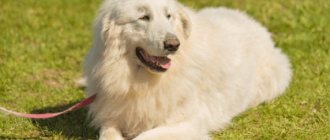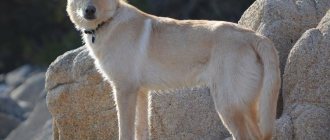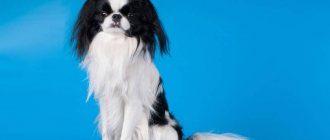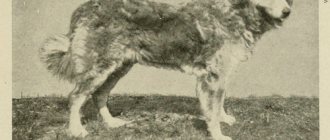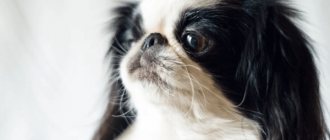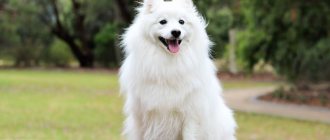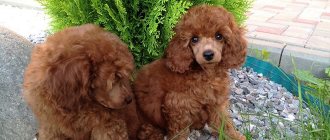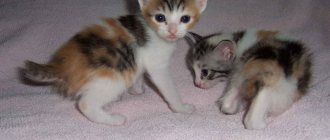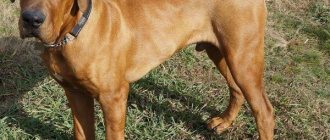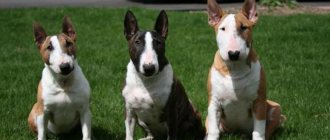History of the Japanese Chin
Japanese Chin
It is indisputable that the Japanese Chin is one of the oldest dog breeds, but versions of its origin are still being discussed. According to one of them, the breed is truly Japanese, another claims that chins were brought to the Land of the Rising Sun from neighboring countries of South Asia, but the routes along which they got there are not exactly known. There is a legend that a pair of dogs similar to the Japanese chin were presented as a gift to the Japanese Emperor Semu by the ruler of one of the Korean states of Silla in 732. It is also possible that these dogs settled in the Japanese imperial court back in the 6th-7th centuries. The earliest estimated date for the appearance of chins in Japan is the 3rd century, and India and China are considered the exporting countries in this case.
Recently, historians in the field of cynology are inclined to believe that the Japanese Chin is one of the many breeds that belong to the so-called “toy” dogs of China, which trace their ancestry to Tibetan dogs. Among them, in addition to the Chin, they also include the Shih Tzu, Lhasa Apso, Pekingese, Pug, and Tibetan Spaniel, which, by the way, has nothing in common with the hunting spaniel. All these animals are distinguished by a large head, large eyes, a short neck, a wide chest, and thick hair - features that indicate their adaptability to the highland climate. The version of the family ties connecting these dogs is confirmed by recent genetic studies. Graceful miniature dogs have been bred for centuries, living in Buddhist monasteries and imperial courts. It is known that the religious and secular elites of Tibet, China, Korea, and Japan exchanged their pets and presented them to each other as gifts.
The first written sources describing the Japanese chin date back to the 12th century. Like their relatives, they were considered sacred and were adored by their owners - crowned persons and representatives of the aristocracy. Legends were written about chins, their images decorated temples and luxurious porcelain vases, and craftsmen working with wood, ivory, and bronze embodied the image of these miniature animals when creating elegant figurines. Purposeful work on breeding this breed began in Japan in the 14th century; information was entered into stud books and kept in the strictest confidence. It is known that the most valued were very miniature pets, which easily fit on small sofa cushions, in the sleeves of the kimonos of noble ladies, they were even placed in hanging cages, like birds. In the 17th century, the families of the daimyo, the samurai elite, chose the hin as their mascot. Commoners were prohibited from keeping Japanese chins, and their theft was considered a crime against the state and was punishable by death.
Japanese Chin puppy
The origin of the breed's name is also controversial. It is believed that the word “hin” comes from the Chinese almost consonant word meaning “dog”. According to another version, it comes from the Japanese “hii”, meaning “treasure”, “jewel”, which, by the way, was quite consistent with its status in monetary terms.
According to some data, although not fully clarified, the first Japanese chins were brought to Europe in 1613 by Portuguese sailors. One of the dogs, or a couple, ended up at the court of the English King Charles II, where they became the favorites of his wife Catherine of Braganza. Perhaps at the same time representatives of this breed appeared in Spain. More reliable information indicates that Japanese chins appeared in Europe and the New World thanks to US Navy Commodore Matthew Calbraith Perry, who led an expedition to Japan in 1853 to establish trade relations. He delivered five of the chins presented to him as a gift by the Japanese Emperor to his homeland, and one pair was presented to Queen Victoria of England.
The development of trade between Japan and European countries, which began in the middle of the last century, opened up the possibility of exporting chins to the continent, and systematic breeding of the breed began in many countries. In Europe, Japanese Chins quickly gained popularity as companion dogs and became favorites of queens, empresses and ladies of high society. They inherited the tradition of the Japanese elite and presented their pets to each other as gifts. The Chins prospered at the courts of all the royal families of Europe. The most famous lover of these dogs was the wife of the English monarch Edward VII, Queen Alexandra, who never parted with her many favorites. Members of the family of Emperor Nicholas II also adored their little pets. By the way, the Soviet elite also favored this breed. One of the most famous owners of the pampered Japanese Chin was the stern Marshal Georgy Zhukov.
The breed was first shown at an exhibition in Birmingham in 1873. Here the chin appeared under the name “Japanese spaniel”. In the USA, this name was retained for dogs until 1977. The American Kennel Club recognized this breed under this name back in 1888, and it is one of the earliest registered by this organization.
In the 20s of the last century, systematic work was carried out to improve the Japanese Chin breed. Before World War II, selection was carried out in several directions. The largest representatives of the breed were called Kobe, the medium-sized ones were called Yamato, and the almost dwarf ones were called Edo. The appearance of modern Chins contains features of all three types of dogs.
The FCI recognized the Japanese Chin as a distinct breed in 1957, classifying it as a toy and companion dog.
In the Soviet Union, few people knew about the breed until the 80s of the last century, when six chins arrived in Moscow, presented as a gift to Russian diplomats upon completion of their service in Japan. With the help of these dogs, Russian chin enthusiasts set to work to improve the health and improvement of the breed. Today, in many nurseries in Moscow and St. Petersburg, Japanese chins are bred, whose ancestors were these six souvenir animals.
Black and white and red and white Japanese chins
Origin
The name of the breed first appeared in 1893 in Japan. Originated at the imperial court. In those days it was considered the most expensive dog, which was given only to important persons of imperial blood.
There are several versions of the origin:
- from a Tibetan spaniel, which became a gift to the Japanese emperor from the monks;
- the monks developed a new breed for active foreign trade with other countries;
- The breed was bred exclusively in Japan, as evidenced by frescoes on ancient buildings.
In Japan, the breed was considered divine for its appearance and character.
Appearance of the Japanese Chin
Charming Japanese Chin
The Japanese Chin is distinguished by its tiny size and delicate constitution, and the more miniature the dog is within the standard, the higher it is valued. These graceful dogs have a square format, determined by the equivalence of the height at the withers, which should not exceed 28 cm, and the length of the body. For females, some elongation of the body is acceptable.
Frame
The dog has a short and straight back with solid bones. The loin is wide and rounded. The chest is quite voluminous and deep, the ribs are arched and moderately curved. The stomach is tucked.
Head
The skull has a wide, rounded shape, the transition line from the forehead to the muzzle is sharp, and the stop itself is deep and depressed. On the short, upturned muzzle, just above the upper lip, “pads” are clearly visible. The nose is located in line with the eyes. Its color can be black or match the color of the color spots. Wide, open vertical nostrils facing forward.
Teeth and jaws
Teeth should be white and strong. Often there are partial teeth and absence of lower incisors, which, however, according to the standard, is not included in the register of defects of the breed. An overbite is preferred, but an underbite and a scissor bite are also acceptable. Wide short jaws are pushed forward.
Eyes
The Japanese Chin's round, black, shiny eyes are set wide apart. They should be expressive and large, but not huge and too convex. Dogs belonging to purely Japanese selection lines are characterized by an astonished expression on their faces. This cute feature is manifested thanks to the animal’s slanted, unfocused gaze, which is why the whites in the corners of its eyes are clearly visible.
Ears
The triangular ears are set wide and covered with long hair. The ears hang down, leaning forward, but if the dog is alarmed by something, they rise slightly. The ear material should be light, thin, and not heavy, like a spaniel's.
Neck
The short neck of the Japanese Chin is characterized by a high carriage.
Japanese Chin muzzle
Limbs
The forearms of the forelimbs are straight and fine-boned. The area below the elbow, behind, is covered with flowing fur. For the front limbs, we can allow markings, which gives the Japanese a reason to compare the dog with a person shod in geta - traditional shoes made of wood. Angles are visible on the hind limbs, but they are moderately expressed. The back of the thighs is covered with long hair.
Small paws have an elongated oval, hare-shaped shape. The fingers are tightly clenched. It is desirable that there are fluffy tassels between them.
Movement
Japanese Chin playing with a ball
The hin moves elegantly, easily, proudly, measuredly, raising its paws high.
Tail
The tail, curled in a ring, is thrown back. It is covered with spectacular long fur, flowing and fanning out.
Wool
The Japanese Chin has a silky, straight, long coat that flows like a lush coat. The dog has practically no undercoat. On the ears, tail, hips and especially on the neck, hair grows more abundantly than on other parts of the body.
Color
The breed is characterized by a spotted black and white color or white with red spots. The second option implies any shades and intensity of red color for spots, for example, lemon, fawn, chocolate. It is not advisable to breed Japanese Chins with dark chocolate spots, as they often give birth to sick and even dead puppies.
The spots should be symmetrically distributed around the eyes, cover the ears and preferably the entire body, along which they can be located randomly or balanced. The latter option is more preferable, as is the presence of clear boundaries of the spots. It is very desirable to have such a detail as a white mark, which should run from the bridge of the nose to the forehead; there may be a small black spot on it, called the “Buddha finger”.
Defects and vices of the breed
- Humpbacked or depressed back.
- Dogs with black and white coats have a nose that is not black.
- Curvature of the lower jaw, underbite.
- Total white color with no spots, one spot on the face.
- Painful fragility.
- Shy behavior, excessive fearfulness.
Breed characteristics
The Japanese Chin is infinitely happy when his owner comes and finds pleasure in being with his family. The dog does not take up much space in the apartment; it is enough for it to have its own small corner, where it can sometimes retire for a quiet rest.
Chins are friendly not only with family members, they get along well with other cats and dogs, and enjoy playing with children. When he sees a stranger, the dog will try to hide in a secluded corner, and once he gets acquainted, he will happily play and have fun.
Note! The dog is quite fragile and miniature. Therefore, it is not recommended for families with small children to have one.
The dog is very affectionate to his owner and members of his family, and he cannot be left alone for a long time. The pet's psyche may be seriously damaged. This is the type of dog that is terrified of losing its owner and cannot imagine its life without him.
Relax in a secluded corner
Photo of Japanese Chin
Personality of the Japanese Chin
Japanese Chins are distinguished by their intelligence, intelligence, and balance. They are agile, but not fussy, unexpectedly courageous, and in case of danger for themselves or their owners, their courage can develop into recklessness. The dog never retreats in front of the enemy, but since it cannot enter into battle due to its size, it spits, screams or hisses like a cat. By the way, its similarity with a cat also lies in the ability to meow, climb high surfaces, finding itself in the most unexpected places, and retire by finding a secluded corner. Chins are proud and unobtrusive - if their owners are busy, they will not bother you, but will simply wait delicately until they pay attention.
Japanese Chin and cat
These dogs are characterized by exceptional cleanliness. They are always ready to be washed and are able to take care of their fur on their own. If a couple of pets live in the house, they will happily lick each other's faces and clean their paws. Chins are completely harmless - they do not damage furniture, do not chew cords and shoes, do not create much noise, and they do not bark often.
Japanese Chins are incredibly proud and love to be admired. But they don’t like familiarity, and they are wary of strangers, not allowing themselves to be touched. When surrounded by family, these dogs show love and friendliness, while choosing a favorite that they idolize. They treat other animals, including cats, kindly and are not afraid of large dogs. Chins get along well with children, but it is not recommended to keep them in a family where the baby is growing up: a child, through negligence, can injure the animal.
Moderate activity and balanced temperament allow the Japanese Chin to feel comfortable in any family. With owners who prefer an active lifestyle, he will happily go for a long walk or jog, go swimming, and with homebodies or elderly people he will share a place on the sofa, burying himself in a pile of plush pillows. Unobtrusive and delicate, the Chin is an excellent companion for people prone to loneliness. However, all owners should keep in mind that these gentle dogs must know that they are truly loved, otherwise they will feel completely miserable.
Hins love to travel and recognize any means of transportation, be it a car, a motor boat, or an airplane. A bicycle basket will also suit them quite well.
Japanese Chin - traveler
Owner reviews
Japanese Chins are very brave and lively dogs with self-esteem and an independent, unobtrusive character. Johnny, being at home with us, never barks or makes noise, and behaves quietly and calmly. Johnny is very clean, he never picks up anything on the street or takes anything from strangers.
swetluschka
https://otzyv.pro/reviews/otzyvy-yaponskiy-hin-19398.html
An excellent watchman for an apartment, but he doesn’t bark in vain, he’s an active, brave and proud dog. An ideal dog for an apartment: the chin is clean, undemanding in feeding, intelligent, cheerful and unpretentious. At the same time, the chin does not create unnecessary noise and takes up very little space.
Yamador
ihttps://doggi.ru/forum/10–322–1
She has such character traits as shyness, shyness, timidity. This is a companion dog. Quite a sweet and calm dog. Stable psyche.
Irina
https://vseotzyvy.ru/item/21037/reviews-yaponskij-hin/
The Japanese Chin is a suitable choice for those who want a companion dog but cannot afford a large breed. Caring for it does not require significant effort. Khin has a calm temperament, does not create much noise, and makes contact with all family members.
- Author: Yana Dmitrova
Hello! Let's get acquainted, my name is Dmitrieva Yana, a manager of foreign economic activity by education. Rate this article:
- 5
- 4
- 3
- 2
- 1
(1 vote, average: 5 out of 5)
Share with your friends!
Raising and training the Japanese Chin
Despite its small size, the Japanese Chin, like any other dog, needs training and education. Pets easily learn commands, and if desired, they can be taught to perform various funny tricks.
Raising a Japanese Chin
During training, it is unacceptable to raise your voice at the dog and, especially, to use physical punishment. It is advisable not to roughly touch the animal’s face and tail during the training process. You should also not make sudden movements - this can disorient him and even provoke aggression. It is better to conduct classes in the form of a game, and you should not be overzealous with repeating the same command; let the hin perform it five or six times during the lesson - that will be enough.
It has been noticed that among Japanese Chins there are very few pets that dog lovers call food eaters because they learn with the help of rewarding treats. But it is necessary to praise the dog, tenderly calling it by affectionate names - this will only help it to fully demonstrate its intelligence.
Price
The Japanese Chin is a prestigious dog breed. But, since it is widespread throughout the CIS, its cost cannot be called high. Dog breeders sell young representatives of the breed from 4.5 to 12 thousand rubles. We strongly do not recommend that you overpay! Do not believe a private owner who assures you that the price of this breed (without documents) can be higher than 10-12 thousand rubles. This is a lie.
If you want your pet to win dog competitions and receive prizes at exhibitions, you will need to purchase documents for it in advance, including a pedigree. The price of Japanese Chin from the nursery is from 800 to 100 dollars.
By purchasing a dog in such a structure, you can be sure that its appearance and character are completely standardized. But, if you decide to buy a puppy from a breeder with whom you have never collaborated before, then be prepared to pay for a “pig in a poke.”
Care and maintenance
Caring for a clean and unpretentious chin is absolutely simple. It is advisable, of course, to take him for a walk three times a day, but it is permissible to limit himself to one walk, having accustomed the dog to a home litter box. In bad weather, you can walk with your dog, holding it in your arms, or dress your pet in a waterproof overall. During hot weather, it is advisable to walk your dog in the shade, as overheating may cause the dog to suffocate. For walks with your chin, choose not a collar, but a chest harness - a kind of harness, since its neck is quite delicate. Please note that these dogs, being without a leash, can easily climb the first height they come across, for example a children's slide, so you need to make sure that the little pet does not fall and injure itself.
Japanese Chin with Yorkshire
Caring for the coat of the Japanese Chin is also not difficult. He does not need model hairstyles, and the haircut is only hygienic, requiring only the removal of overgrown hairs. It would be good to brush your pet daily; in any case, this procedure should be performed at least twice a week, accustoming the dog to it from puppyhood.
Cinchona is bathed as needed, but not more than once every two weeks. Paws and ears are washed as they become dirty. For bathing, use zoo shampoos, which, in addition to the cleaning effect, also have antimicrobial and antiparasitic properties. After washing with shampoo, treat the dog's coat with conditioner - this will make it fluff up and smell nice. After the procedure, the Japanese Chin must be dried so that it does not catch a cold. You can use a towel or hairdryer.
As an alternative to bathing, you can use a dry method of cleaning the animal's fur using a special powder. Some owners use talc or baby powder for this procedure. The product should be carefully rubbed into the pet’s fur, making sure that some of it gets on his skin. After powdering, thoroughly comb the animal's fur until the powder disappears completely. This method allows you to effectively clean the coat of dirt and dead hair.
Grooming of the Japanese Chin
The claws of Japanese Chins grow very quickly, while they bend and split, which causes discomfort to the dog. They should be trimmed using a nail clipper as they grow, usually at least once a month. The dog will be especially grateful to the owner for this cosmetic procedure.
The diet of chins should be high in calories. These dogs don’t eat much, but they move very actively, even when living in an apartment. The diet should include foods containing sufficient amounts of protein and calcium. For animals of this breed, the following products are preferred and must be alternated: turkey meat, chicken, lean beef, boiled liver, tripe, kidneys, sea fish (no more than once a week), boiled yolk (two to three times a week). Periodically you need to give rice, boiled vegetables, raw pitted fruits.
The finished food must be premium or holistic.
It is important not to overfeed your chin, because it quickly gains excess weight, and this negatively affects its health.
It is advisable that the gentle Japanese Chin be periodically examined by a veterinarian for preventative purposes. For older animals, veterinary examinations are recommended regularly.
Japanese Chin after shower
Nutrition
The breed is not picky about the type of food unless there are any obvious contraindications or allergic reactions. An unbalanced diet may cause problems. It should be noted that the dog has a strong appetite - it can eat until the bowl is empty. Control your portion size. Teach your chin to a strict feeding schedule from childhood.
To balance your diet, create a diet that contains nutrients. The following daily meal options are possible:
- natural – includes natural food products;
- industrial – includes factory-made dry food;
- mixed - consists of a combination of the above options.
To tailor nutrition to suit your pet's needs, consult your veterinarian. Monitor your dog's reaction after eating. Try not to suddenly change your pet's eating habits.
Premium dry dog food
Rating
Holistic dog food
Rating
Small breed dog food
Rating
Health and Diseases of the Japanese Chin
Japanese Chins, despite their subtlety, cannot be called sickly dogs, and the main ailments that are characteristic of these animals are characteristic of most all small dog breeds. However, there are a number of diseases associated specifically with breed predisposition and heredity, and this is not an accident.
Japanese Chin with protective collar
The original, bright features of the appearance of chins have been formed since time immemorial, appearing unexpectedly and attracting ancient breeders from South Asia and the Far East. Dogs with a distinctive appearance were used for breeding, but their expressive external features were associated with nothing more than mutations that gradually changed the gene code of the breed. The cute “highlights” of the appearance of Japanese Chins were confidently passed down from generation to generation, and today they are captured in the breed standard. However, being not harmless in their biological basis, they can be the source of serious diseases. Fortunately, not every dog inherits abnormal genes.
Among Japanese Chins, as well as among their fellow tribesmen with a flat muzzle, that is, shortened facial bones of the skull, brachycephalic syndrome is widespread - a change in the structure of the upper respiratory tract, leading to disruption of their functioning. Even at a comfortable air temperature, these babies have difficulty breathing, and in hot and cold weather it is especially difficult for them to breathe. In hot weather, they may suffer from heatstroke.
Grooming of the Japanese Chin
Japanese Chin puppies sometimes develop hydrops of the brain in the first weeks of life, which in some cases can lead to fatal consequences. Rare but possible diseases include GM2 gangliosidosis, a hereditary defect that catastrophically disrupts the functioning of the central nervous system.
Another possible genetic abnormality is distichiasis, which manifests itself in the formation of an additional row of eyelashes, which leads to irritation of the mucous membrane of the eyeball and can cause constant tearing, strabismus, erosion and ulceration of the cornea. Other eye diseases include cataracts, progressive retinal atrophy, and entropion.
Disturbances in the function of the endocrine system in combination with the specifics of genetics are manifested in the Japanese Chin in the misalignment of the jaw, multi-teeth or false polyodontia, which occurs due to delayed loss of milk teeth. Failure of the dental system, in turn, leads to dysfunction of the digestive system.
Among the defects inherent in small breeds of dogs, which are also characteristic of the Japanese Chin, are underdevelopment of the reproductive system, as well as disruption of the musculoskeletal system, which manifests itself in frequent dislocations of the patella and necrosis of the femoral head. Excessive curvature of the tail can cause suffering to dogs.
It is worth considering that after 8 years, when bitches reach the end of their childbearing years, they begin to age, lose teeth, and often experience exacerbations of chronic ailments. From the age of 10, Chins often have hearing problems.
You need to know about one more feature of the breed - these dogs tolerate anesthesia very poorly.
Who is the dog suitable for?
These dogs are created for a quiet life , but easily adapt to human needs. The potential owner can be of any character, but must understand that the breed is not intended for protection, sport or hunting.
Chinchines are the best option for families with children, other animals, for pensioners and single people. They often live with other dogs and cats of all breeds and sizes.
It is necessary to constantly communicate with him, despite the external independence of the pet. He will definitely demand affection, but will leave when he gets bored. There is no aggression or hunting instinct in the breed and the dogs will get along well with children.
How to choose a puppy
Whatever kind of Japanese Chin puppy you decide to buy - a show-class dog or just a pet, it is important, first of all, to choose a seller. This can be a reliable, responsible breeder, and ideally, the owner of a breeding nursery that has a good reputation and a documented history of breeding the breed in this particular nursery. Professionals in their field will always select exactly the puppy you dream of, issue documents confirming that he is healthy, a certificate of pedigree, and characteristics of his potential breeding qualities.
First, make sure that the puppies are kept in a clean room and observe them. Check to see if all puppies from the same litter look healthy, are active, and are well fed. Examine the baby that you like the most from head to tail. Make sure that his ears are clean, without redness, his eyes are clear and playful, his gums are pink, his teeth are white, his fur is silky and shiny. Suspicion should be raised by any sign of underbite or overbite.
Take a closer look at the Chin you like at the moment when he plays. Such an observation will help to notice whether he has noticeable defects: a “cow-like” stance of the hind legs, their instability, an excessively lowered sternum. These shortcomings are rarely leveled out with age.
It is very important to make sure that the parents of your potential pet do not have diseases, and also to clarify whether the bitch was ill during pregnancy, since in this case the puppies may develop pathologies, including such a dangerous disease as hydrocephalus. You also need to take a closer look at the puppy’s mother, and if you choose a Japanese Chin with show prospects, it is advisable to see both parents.
Mating
Mating is carried out no earlier than the 3rd heat in females, at approximately the age of 1.5 - 2 years . Males are allowed to breed no earlier than 18–19 months of age. Before mating, it is recommended that both parents undergo deworming treatment to avoid contamination of the litter.
A date with a male dog is scheduled no earlier than the 10th day of estrus. Depending on the duration of estrus, ovulation can occur either on the 10th or 19th day of sexual heat. After the first lock, a double mating is carried out within 24 hours to ensure that offspring are obtained.
Photos of Japanese Chin puppies
How much does a Japanese chin cost?
You can buy a Japanese Chin “from hand” for an amount from 4,500 to 10,000 rubles.
But in this case, you run the risk of acquiring a pet whose purity will be in question. The baby may turn out to be a mixed race. In the best case, one of his parents will be a Pekingese, which unscrupulous breeders often breed with the more expensive Chin. In kennels, pet class puppies cost from 10,000 rubles, babies of the most popular breeding class cost from 15,000 rubles. Show-class dogs with exhibition prospects cost at least 25,000 rubles. The best of them can be sold for an amount exceeding 60,000 rubles.
Prices in different nurseries vary and depend on their location, the reputation of the owners, and the breeding stock.
Pet sterilization
Sterilization/castration is a controversial procedure that requires an informed decision
The need for sterilization raises serious doubts among some owners. To make the right decision, you need to consider the positive and negative aspects of this procedure.
Pros:
- increasing the animal's lifespan by 3–5 years;
- prevention of diseases of the ovaries, uterus, mammary glands;
- exclusion of accidental matings and the appearance of unwanted puppies;
- positive changes in the behavior of the dog, which will not mark and howl in the apartment.
The downside of sterilization is possible complications after surgery. But they can be avoided if you follow all the veterinarian’s recommendations regarding animal care. Thus, sterilization has significantly more advantages than disadvantages. But the decision to carry out the operation still remains with the owner.

